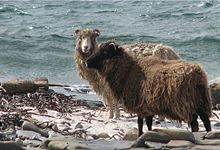North Ronaldsay (sheep)

Two sheep on the shoreline of North Ronaldsay
|
|
| Conservation status | |
|---|---|
| Country of origin | Scotland |
| Use | Meat, Wool |
| Traits | |
| Weight |
|
| Height |
|
| Wool color | White, grey, brown, black |
| Horn status | Horned |
|
|
The North Ronaldsay or Orkney is a breed of domestic sheep from North Ronaldsay, the northernmost island of Orkney, off the north coast of Scotland. It belongs to the Northern European short-tailed sheep group of breeds, and has evolved without much cross-breeding with modern breeds. It is a smaller sheep than most, with the rams (males) horned and ewes (females) mostly . It was formerly kept primarily for wool, but now the two largest flocks are feral, one on North Ronaldsay and another on the Orkney island of Linga Holm. The Rare Breeds Survival Trust lists the breed as "vulnerable", with fewer than 600 registered breeding females in the United Kingdom.
The semi-feral flock on North Ronaldsay is the original flock that evolved to subsist almost entirely on seaweed – they are one of few mammals to do this. They are confined to the shoreline by a 1.8 m (6 ft) tall dry-stone wall, which completely encircles the island, forcing the sheep to evolve this unusual characteristic. The wall was built originally to protect the shoreline and keep the sheep inside it, but as seaweed farming on the shore became uneconomical the sheep were banished outside to protect the fields and crofts inside.
This diet has caused a variety of adaptations in the sheep's digestive system. These sheep have to extract the trace element copper far more efficiently than other breeds as their diet has a limited supply of copper. This results in them being susceptible to copper toxicity, if fed on a grass diet, as copper is toxic to sheep in high quantities. Grazing habits have also changed to suit the sheep's environment. To reduce the chance of being stranded by an incoming tide, they graze at low tide and then ruminate at high tide.
...
Wikipedia
